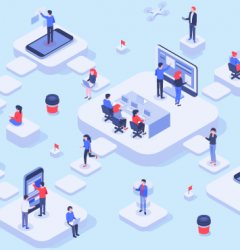
An increase in technology budgets does not implicate accelerated innovation. Most of that budget goes into maintaining, updating, and fixing 500,000 lines of code for the IT System. In today’s rapidly expanding technological landscape, new codes are becoming legacy codes in no time, and the burden of legacy applications is piling on.
IT teams are largely spending their energies on updating redundant applications, contemplating workarounds, and doing patchwork to keep the existing infrastructure running instead of driving digital transformation and contributing to greater strategic objectives. In other words, they cannot get out of this technical debt, because of which empowering your current IT systems becomes essential.
Turning an aspiring coder into a trained and experienced developer takes time. However, technological evolution doesn’t wait long, so the existing IT skills seldom fulfill the requirements of tech innovations. Companies are increasingly finding it difficult to acquire the right technical talent for the right job, and they are helplessly maintaining a huge IT backlog with a limited pool of experienced developers. As a result, they are either delaying or derailing their product releases and planned digital transformation initiatives.
There is research by Gartner that indicates the need for new skillsets for 58% of the workforce. According to Korn Ferry, failing to have the skills to support and expand the business will cost the world’s economies more than $8.3 trillion by 2030.
To mitigate this financial impact, enterprises need a flexible and versatile workforce that can quickly transform existing IT systems and build complex applications with fewer resources. They should consider strategies that let them bolt new cloud and mobile capabilities onto their current software to accelerate modernization while steadily reducing technical debt. That way, they can modernize at their own pace, without the risk of rip-and-replace, to meet today’s requirements as well as future needs.
Also Read: From Coding to Strategic Leadership: Quixy Levels Up Your IT Game
IT and business teams need to align priorities
In terms of delivering innovative solutions and value to customers, IT and business teams share the same intent, but when it comes to their priorities, they aren’t aligned. They face their unique set of challenges which invokes frustrations on both sides.
Tech disruptions, along with the need for rapid updates and modifications, continue to demand new services and innovation from IT departments. It’s unsurprising that a huge portion of the budget goes into keeping existing systems up and running. Moreover, the shortage of highly skilled programmers creates a challenging situation that increases time to market, overburdens IT teams, and leaves business users with inadequate technical resources.
One anticipated result is that lines of business turn to no-code platforms and build their own priority-specific applications – for example, to automate their critical workflows – thereby democratizing application development and reducing the burden on IT.

Empowering Your Current IT Systems for Success
Thanks to no-code platforms and development tools, the democratization of application development is happening at a rapid pace. No-code platforms provide software development environments that enable people with little or no coding experience to build and modify applications. These platforms curtail the dependence of business users on already-overburdened IT teams by enabling them to build applications with pre-configured components and a simple drag-and-drop mechanism.
According to Gartner, No-code accounted for 70% of app development in 2025, and this trend is likely to grow as 60% of current low-code/no-code users expect their weekly usage of the platform to increase.
Our Rescale-Rejig-Reform or 3R model encapsulates different purposes of transforming existing IT systems with no-code platforms.
Also Read: Why Businesses shouldn’t overlook the Power of No-Code for Customer Experience?
1. Rescale
With no code, you can rescale your existing systems with new touchpoints and create new customer experiences tailored to your company’s objectives without the risk, cost, or need for specialized skills for the traditional customization of your legacy system.
Take your enterprise IT systems like a house, “rescaling” is analogous to adding a new window. A rescale approach works effectively when core systems are operational (the house is strong), and you only need to swiftly add new capabilities or customer journeys to meet pressing business needs.
No-code platforms offer a rapid way to build role-specific views into enterprise data without altering the original system architecture. They offer pre-built connectors to some common enterprise systems, such as SAP, Salesforce, and Microsoft Dynamics, so you can get the data you need quickly.
Business users can leverage pre-designed templates to build working prototypes to gather initial feedback and gradually transition to a full-fledged application by adding data, integrations, and business logic.
Also Read: Strategy for Problem-Solving Culture with Citizen Development
2. Rejig (Refactor)
With no-code, you can rejig(refactor) your systems by reorganizing certain components and developing a modular, interoperable architecture that you can adjust at your convenience.
Rejigging legacy systems is pretty similar to rearranging your floor plan. You start with a room that requires significant modifications, and gradually you reorganize other rooms until you renovate your entire house.
Rejigging(refactoring) helps you modernize your legacy IT stack at your own pace. You can address your urgent requirements, such as modifying specific functions and integrating them with the rest of the environment. Gradually, you can transform into a modern decoupled architecture.
Also Read: Can No-Code App Development give your company a Competitive Edge?
3. Reform(Rebuild)
With no-code, you can reform or rebuild systems from scratch to create exactly what you need, just like how you can take down your house brick by brick and build it from scratch. If your legacy systems have outlived their utility or no longer meet your priorities, then ‘Reform’ is the best approach to follow. Like rescaling and refactoring, reforming is not about leaving your legacy system behind; in fact, it is about tapping the possibilities of old data sources for the new systems until the new cloud system is ready for the complete switchover. With this approach, you can have purpose-driven, cloud-native applications that meet your organization’s requirements.
Also Read: Why Tech-Ops Friction Is Costing Enterprises: And How to Fix It With No-Code + AI
Conclusion
Unleashing the potential of your existing IT systems requires no-code, which in turn requires democratization, which in turn requires a proper demarcation of roles and responsibilities among IT and business teams. It’s high time we evolved our ways of managing and governing technology-based innovation. Only then can you seamlessly adopt this 3R model.
Frequently Asked Questions (FAQs)
Q. How can No-code help IT teams in an organization?
No-code platforms are software development environments that enable individuals with minimal coding experience to create and modify applications using a simple drag-and-drop mechanism. They aid in the transformation of existing IT systems by empowering non-technical users to build tailored applications without overwhelming IT teams.
Q. How can 3R model (Rescale, Rejig, Reform) be applied to existing IT system?
The 3R model, involving Rescale (adding new capabilities), Rejig (reorganizing components), and Reform (rebuilding from scratch), provides flexible approaches to enhancing IT systems. No-code platforms facilitate these transformations without the need for extensive coding skills.
Q. What advantages do no-code platforms offer in updating legacy IT systems?
No-code platforms streamline the process of updating legacy systems by allowing for quick modifications, integrations with existing architectures, and the creation of new customer experiences without extensive coding or specialized technical skills.
Q. How does democratizing app development alleviate the burden on IT teams?
Democratizing application development enables business users to create priority-specific applications independently, reducing the load on IT teams. This empowers users to automate critical workflows and generate customized solutions, easing the strain on IT resources.
Q. How do no-code platforms fit evolving workforce and tech needs?
No-code platforms align with the demand for a versatile workforce by enabling rapid application development without relying solely on highly skilled programmers. They accommodate evolving technological needs by facilitating quick adaptations and updates to meet business requirements.
Login
Please login to comment
0 Comments
Oldest















